Apple MacBook (13-inch, Aluminum, Late 2008) 08-10 Service Manual
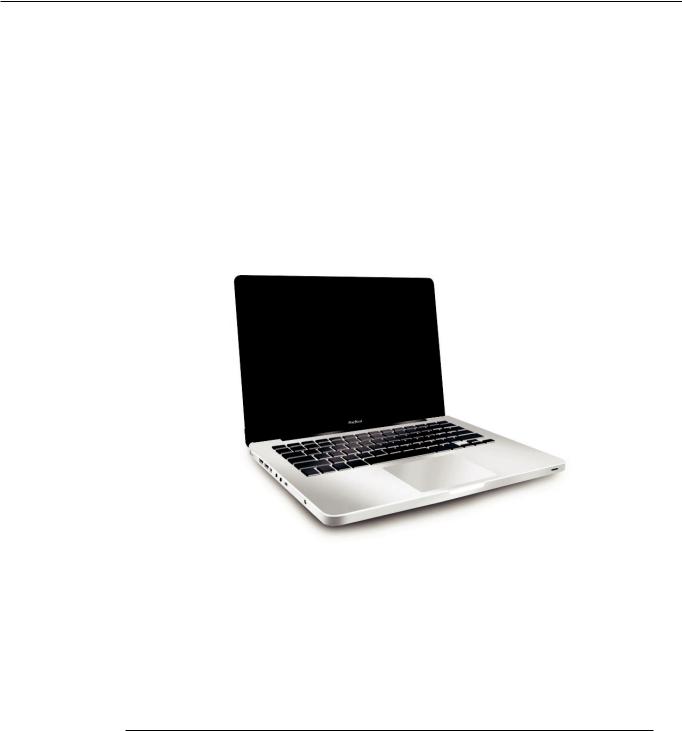
Service Source
MacBook (13-inch, Aluminum, Late 2008)
Updated: 2008-10-19

Apple Inc.
© 2008 Apple Inc. All rights reserved.
Under the copyright laws, this document may not be copied, in whole or in part, without the written consent of Apple.
Every effort has been made to ensure that the information in this document is accurate. Apple is not responsible for printing or clerical errors.
Apple
1 Infinite Loop Cupertino, CA 95014-2084 USA
+ 1 408 996 1010 www.apple.com
Apple, the Apple logo, Mac, MacBook, and Macintosh are trademarks of Apple Inc., registered in the U.S. and other countries.
MacBook (13-inch, Aluminum, Late 2008)
Contents
Manual Updates 8
Updated 19 October 2008 8
Updated 17 October 2008 8
Manual introduced 14 October 2008 8
Basics
Overview 10
Identifying Features 10
Note About Images in This Manual 11
Serial Number Location 12
Serial Number On Top Case 12
Transferring the Serial Number 12
General Information 13
Required Tools 13
The Glass Panel 14
Troubleshooting
General Troubleshooting |
16 |
||
Update System Software |
16 |
||
Troubleshooting Theory |
16 |
||
Hardware vs. Software |
16 |
||
Emerging Issues |
16 |
|
|
Functional Overview |
17 |
|
|
Block Diagram |
18 |
|
|
Liquid Submersion Indicators 19
Common Reset Procedures 20
Symptom Charts 22
Startup and Power Issues 22
No Power 22
Won’t Start Up 25
Intermittent Shutdown 28
No Video/Bad Video 31

Battery Isn’t Recognized or Won’t Charge 34
Kernel Panic/System Crashes 37 |
|
|
|||
Battery Run Time Too Short |
40 |
|
|
||
Won’t Run on Power Adapter Alone |
41 |
|
|||
Power Adapter Issue |
42 |
|
|
|
|
Noise / Hum / Vibration |
43 |
|
|
|
|
Burnt Smell / Odor |
45 |
|
|
|
|
Battery Leaking or Swollen |
46 |
|
|
||
Uncategorized Symptom |
46 |
|
|
||
Communications 47 |
|
|
|
|
|
Ethernet Port/Device Issue |
47 |
|
|
||
AirPort/Bluetooth:Defective Wireless Devices |
49 |
||||
No/Poor Wireless Signal |
51 |
|
|
|
|
Wireless Input Device Loses Connection 52 |
|
||||
AirPort Card:Kernel Panic |
54 |
|
|
||
Wireless Performance Issue / Slow Connection |
55 |
||||
Wireless Input Device Doesn’t Pair |
58 |
|
|||
Uncategorized Symptom |
59 |
|
|
||
Display 60
Display Anomalies 60
Defective Camera / Built-in iSight Not Operating Correctly 64
Backlight Issue / No Backlight |
66 |
|
|
||
Noise / Unstable Flickering |
67 |
|
|
||
Mechanical/Physical Damage |
68 |
|
|
||
Cosmetic Defects |
68 |
|
|
|
|
Uncategorized Symptom |
68 |
|
|
|
|
Mass Storage 69 |
|
|
|
|
|
Hard Drive Read/Write Issue |
69 |
|
|
||
Hard Drive Not Recognized/Not Mounting |
70 |
||||
Hard Drive Noisy |
72 |
|
|
|
|
Optical Drive Won’t Accept/Reject Media |
73 |
||||
Optical Drive Read/Write Data Error 75 |
|
||||
Optical Drive Not Recognized/Mount |
77 |
|
|||
Optical Drive Noisy 78 |
|
|
|
|
|
Optical Drive Not Performing to Specs |
80 |
|
|||
Uncategorized Symptom |
81 |
|
|
|
|
Input/Output Devices 82
USB Port Does Not Recognize Known Devices 82 Built-in Keyboard Does Not Work Properly 83 Specific Keys Don’t Work 84
Built-in Trackpad Does Not Work 84
Built-in Keyboard Has Dim or No Keyboard Backlight 85 Built-in Keyboard Is Not Recognized 86
Built-in Trackpad Does Not Track Properly 88 Apple Remote Inoperable 89
Built-in Speaker Has No Audio 90 Distorted Sound from Internal Speaker 91 Uncategorized Symptom 93
Mechanical Issues:Thermals and Enclosure 94
Reset/Power Button Stuck 94 System Runs Hot 95 Uncategorized Symptom 97
Take Apart
General Information 99
Connector Types on Logic Board 99
Icon Legend 102
Temperature Concerns 102
Replacement Steps 102
Screw Sizes 102
Access Door 103
Removal 104
Replacement 105
Battery 106
Removal 107
Replacement 108
Hard Drive Bracket 109
Hard Drive 111
Removal 112
Replacement 114
Installing Mac OS X and Applications 116
Installing Applications 116
Bottom Case 117
Removal 118
Replacement 119
Memory 120
Removal 121
Replacement 122
Mid Wall 123
Battery Connector Cover 125
Battery Cable Guide 127
Battery Power Cable 129

Removal 130
Replacement 130
Battery Indicator Light (BIL) Cable 131
Removal 132
Replacement 134
Camera Cable Guide 135
Removal 136
Replacement 136
LVDS Cable Guide 137
Display Assembly 139
Removal 140
Replacement 141
Display Clutch Cover 142
Removal 143
Replacement 144
AirPort Card 145
Removal 146
Replacement 147
AirPort Antenna |
148 |
Optical Drive 150 |
|
Removal 151 |
|
Replacement |
152 |
Optical Drive Flex Cable 154 |
|
Right Speaker / Subwoofer 156 |
|
Removal 157 |
|
Replacement |
158 |
Hard Drive Connector Cable 159
Removal |
160 |
|
Replacement |
161 |
|
Fan 162 |
|
|
Keyboard Flex Bracket 164 |
||
Logic Board |
166 |
|
Removal |
167 |
|
Replacement |
170 |
|
Left Speaker 171
Removal 172
Replacement 173
MagSafe Board 174
Removal 175
Replacement 175
Heatsink 176
Removal 177
Replacement 178
Microphone Cable 180
Removal 181 |
|
Replacement |
182 |
Center Bracket |
183 |
Kensington Lock 184
Hard Drive Front Bracket with IR/Sleep Cable 186
Top Case 188
Views
Exploded Views |
191 |
|
|
Main Assembly, 1 of 2 |
191 |
||
Main Assembly, 2 of 2 |
192 |
||
Display Assembly 193 |
|
||
External Views |
194 |
|
|
Port View |
194 |
|
|
Screw Chart |
195 |
|
|
Screw Location Diagrams 197
Bottom Case 197
Display Assembly 198
Top Case 199

Manual Updates
Updated 19 October 2008
Corrected internal links
Updated 17 October 2008
•Corrected internal links
•Take Apart:Reorganized topic sequence following Display Assembly.
•Exploded View:Display Assembly:Corrected display assembly part number to 661-4820.
Manual introduced 14 October 2008
2008-10-19 |
MacBook (13-inch, Aluminum, Late 2008) Basics — Manual Updates 8 |

Service Source
Basics
MacBook (13-inch, Aluminum, Late 2008)
© 2008 Apple Inc. All rights reserved.
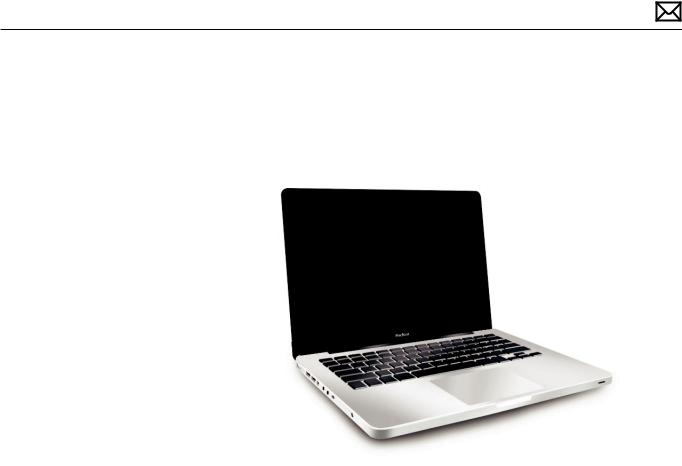
Overview
The MacBook (13-inch, Aluminum, Late 2008) computer features a powerful new NVIDIA GeForce 9400M graphics processor, Multi-Touch trackpad, and aluminum body. Refer to more features below.
Identifying Features
The main features and service differences include:
•Aluminum case
•Glass backlit, glossy, widescreen display panel
•Mini DisplayPort connector
•Battery indicator button on left side
•Illustrations for removing the battery, hard drive, and memory cards are pictured on the inner side of the access door.
•Product identification label is on top case front edge, visible when the access door and battery are removed.
•Logic board, MagSafe board, and some other components have a uniform black color with no component silkscreening.
2008-10-19 |
MacBook (13-inch, Aluminum, Late 2008) Basics — Overview 10 |

Product Configurations
The following table shows the MacBook (13-inch, Aluminum, Late 2008) model configurations at introduction:
Feature |
Better (MN466) |
Best (MB467) |
Intel Core 2 Duo processor |
2.0 GHz |
2.4 GHz |
|
|
|
Memory, DDR3 1066, SO-DIMMs |
2 GB (2 x 1 GB); |
2 GB (2 x 1 GB); |
|
up to 4 GB (2 x 2 GB) |
up to 4 GB (2 x 2 GB) |
|
|
|
Hard Drive, Serial ATA 100 5400 |
160 GB; |
250 GB; |
rpm |
up to 320 GB |
up to 320 GB |
Optical Drive (SATA) |
8x DL Super, 9.5 mm |
8x DL Super, 9.5 mm |
Keyboard |
Backlight on configure-to-order |
Backlight |
Housing |
Aluminum |
Aluminum |
Display |
13.3-inch glass LCD, 1280x800, 114 dpi, LED backlight, |
|
|
glossy finish |
|
Battery |
45-Whr Lithium Ion |
|
Power Adapter |
60 W MagSafe |
|
Note About Images in This Manual
Because a pre-production model was used for most of the images shown in this manual, you may notice small differences in appearance between the image pictured and the computer you are servicing. However, although the appearance may differ, the steps and sequence are the same unless noted.
Screw sizes shown are approximate and indicate the total length including the screw head.
2008-10-19 |
MacBook (13-inch, Aluminum, Late 2008) Basics — Overview 11 |
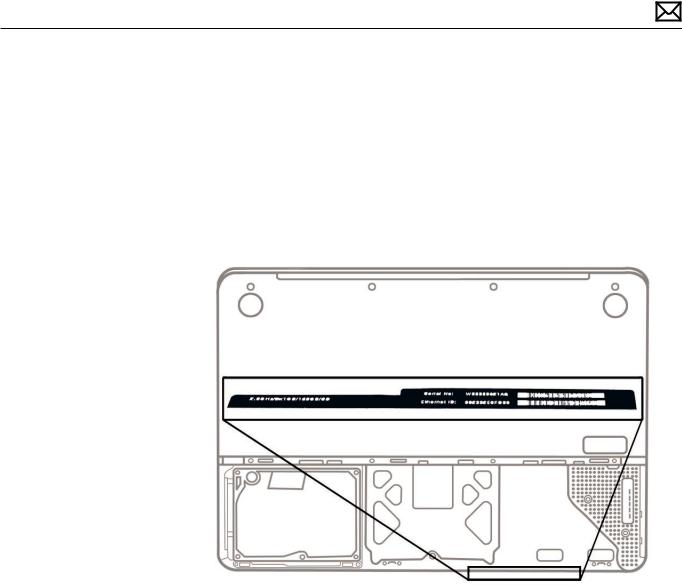
Serial Number Location
Serial Number On Top Case
Remove the access door and battery to see the serial number on the inside front wall of the top case.
Transferring the Serial Number
When replacing a top case, retain the customer’s top case until the repair is complete. Before installing the replacement top case, peel up the serial number label from the original top case and transfer it to the replacement.
2008-10-19 |
MacBook (13-inch, Aluminum, Late 2008) Basics — Serial Number Location 12 |

General Information
Required Tools
Caution: To prevent scratches or other cosmetic damage to the computer housing, use a soft cloth as a protective layer when removing and installing the external screws.
The following tools are required to service the computer:
•Clean, soft, lint-free cloth
•ESD wrist strap and mat
•Magnetic Phillips #0 screwdriver
•Magnetic Phillips #00 screwdriver (preferably with a long handle)
•Torx T6 screwdriver
•Black stick (Apple probe tool, part number 922-5065) or other nonconductive nylon or plastic flatblade tool
•Thermal grease (Apple thermal compound syringe, part number 922-7144)
•Alcohol wipes
•Permanent marking, felt-tip pen (optional)
•Pencil with eraser
•Foam wedge fixture for display assembly removal (Apple part number 922-8779)
•Kapton tape
•Digital volt meter (troubleshooting)
Refer to Knowledge Base article“Hand Tools for Desktop and Portable Repairs--AP/CA/EU/JP/ LA/US”to purchase tools:
http://docs.info.apple.com/article.html?artnum=500200
In addition, the following software programs are required for troubleshooting:
•Apple Service Diagnostic (ASD)
•Apple Hardware Test
2008-10-19 |
MacBook (13-inch, Aluminum, Late 2008) Basics — General Information 13 |
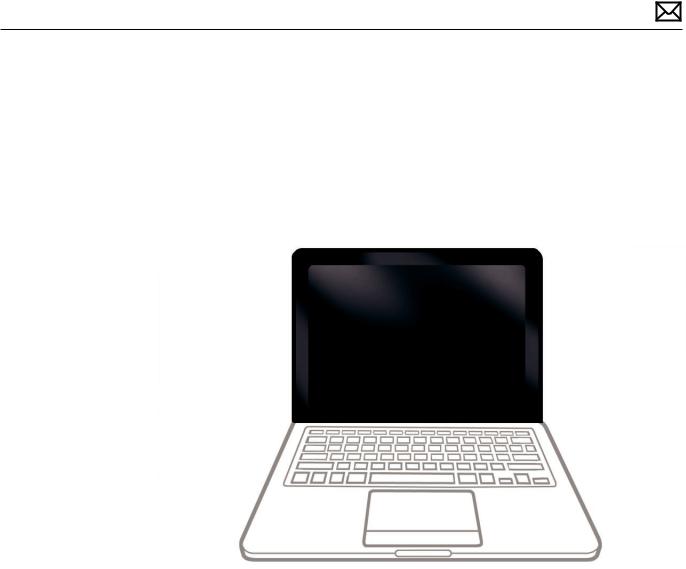
The Glass Panel
Warning: The glass panel for this model is not a serviceable part. If the glass is broken or scratched, replace the display assembly. Attempting to remove the glass can permanently shatter the display face and damage other parts.
To clean the glass panel, use the Apple polishing cloth (922-8245) and iKlear Apple Polish or Brillianize anti-static spray cleaning solution. Alternatively, IPA (isopropyl alcohol) can be used.
2008-10-19 |
MacBook (13-inch, Aluminum, Late 2008) Basics — General Information 14 |

Service Source
Troubleshooting
MacBook (13-inch, Aluminum, Late 2008)
© 2008 Apple Inc. All rights reserved.
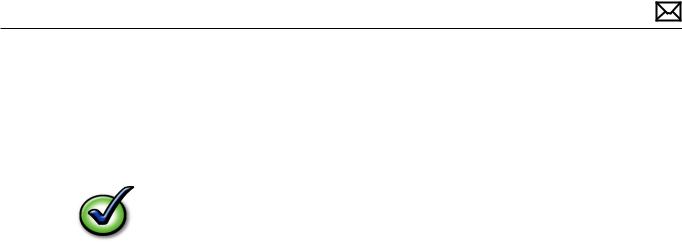
General Troubleshooting
Update System Software
Important: Whenever possible before beginning troubleshooting, ensure the latest software and firmware updates have been applied.
Troubleshooting Theory
For general information on troubleshooting theory, refer to:
http://service.info.apple.com/service_training/en/006/troubleshoot/index.php?page=intro
Hardware vs. Software
For information on how to isolate a hardware issue from a software issue, refer to:
http://support.apple.com/kb/TS1388?viewlocale=en_US
TS1394—Mac OS X:Troubleshooting installation and software updates <http://support.apple. com/kb/TS1394>
HT2956—Troubleshooting Mac OS X installation from CD or DVD <http://support.apple.com/ kb/HT2956>
For information on how to troubleshoot a software issue, refer to:
HT1199—Mac OS X:How to troubleshoot a software issue <http://support.apple.com/kb/ HT1199>
Emerging Issues
For the latest on troubleshooting issues, refer to:
http://support.apple.com/kb/index?page=search&q=khot%20MacBook%20Emerging%20 Issue
2008-10-19 |
MacBook (13-inch, Aluminum, Late 2008) General Troubleshooting — Update System Software 16 |
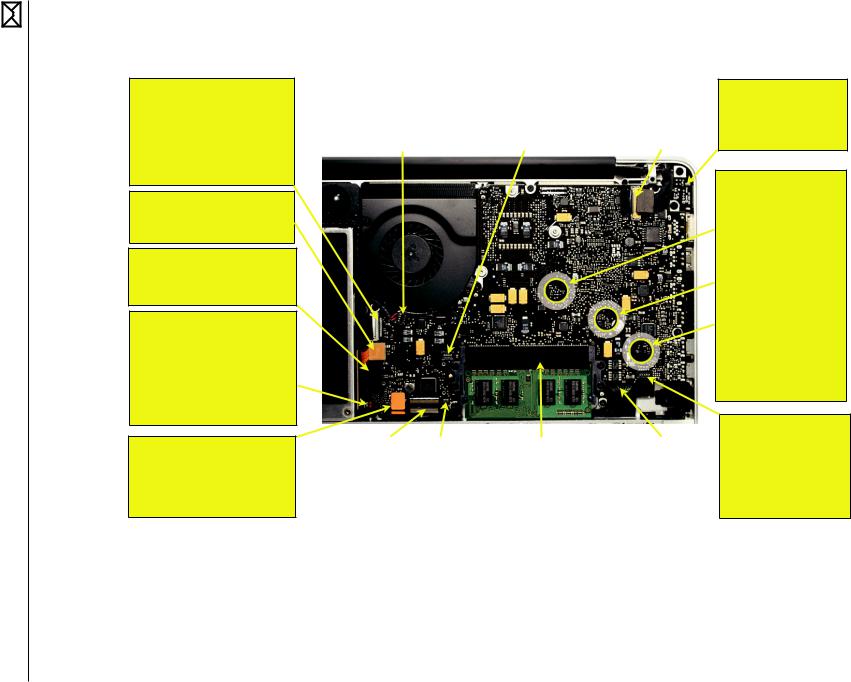
Functional Overview |
Refer to this diagram for symptoms related to logic board connectors. |
Camera (includes AirPort, Bluetooth, camera, and ambient light sensor)
•failure of any parts listed above
•no keyboard backlight
•no startup if AirPort cable short
Optical drive:
•no optical drive visible
•no startup from optical drive
Hard drive:
•no hard drive visible
•no startup from hard drive
Sleep LED, Infrared sensor, magnetic sleep sensor:
•no sleep LED status
•no infrared reception
•no sleep when display closed
•wakes from sleep
•no video on internal display (sensor stuck)
Trackpad, trackpad button thermal sensor:
•no cursor movement
•no click action
•runs slow (no sensor input)
Right speaker/subwoofer: |
|
Fan: |
|
LCD, backlight: |
|
• intermittent shutdown |
|
• no video on internal |
|
• no sound from right speaker or |
|
|
||
|
• freezes |
|
LCD |
|
subwoofer |
|
|
||
|
• noisy fan |
|
• no backlight |
|
• distorted sound from right or |
|
|
||
center |
|
|
|
|
|
|
|
|
|
Keyboard, power |
|
Keyboard |
|
Memory: |
|
Battery (under logic |
on button: |
|
backlight: |
|
• no startup |
|
board): |
• no power |
|
• no keyboard |
|
• pointer unresponsive |
|
• no power when |
• nonresponsive |
|
backlight |
|
and kernel panic |
|
battery only |
keys |
|
|
|
• video artifacts |
|
• no power on |
|
|
|
|
|
|
|
MagSafe connector (under logic board):
•no power on
•no battery charge
Connectors on the other side of logic board:
Heatsink thermal sensor
•no startup
•system shutdown
•pointer unresponsive
Left speaker
•no sound from left
•distorted sound on left
Microphone
• no integrated sound input
Battery indicator LEDs, battery button:
•no battery error
•no battery level while charging
•no battery level shown when button pressed
MacBook (13-inch, Aluminum, Late 2008) General Troubleshooting — Functional Overview 17
2008-10-19

Block Diagram
Refer to this diagram to see how modules are interrelated.
2008-10-19 |
MacBook (13-inch, Aluminum, Late 2008) General Troubleshooting — Block Diagram 18 |

Liquid Submersion Indicators
To help discover accidental damage to the computer, the top case includes spill sensors called liquid submersion indicators (LSI).The sensors are only visible when the bottom case and most of the modules have been removed. Normally represented by small white dots, the LSIs turn red (indicated by the four small, round dots shown below) when they have come in contact with liquid, such as an accidental spill.
For more information, refer to Knowledge Base article TS2274:“MacBook (Early 2008) and later: Liquid submersion indicators (LSI).”
2008-10-19 |
MacBook (13-inch, Aluminum, Late 2008) General Troubleshooting — Liquid Submersion Indicators 19 |

Common Reset Procedures
When a reset procedure is required for troubleshooting, follow the applicable steps:
Resetting the System Management Controller (SMC)
To reset power management via the SMC chip:
1.If the computer is on, turn it off.
2.Disconnect the power adapter and remove the main battery.
3.Hold the power button down for five seconds, then release.
4.Install the main battery and connect the power adapter.
5.Press the power button to restart the computer.
Resetting the SMC means you will also need to reset the date and time (using the Date & Time pane of System Preferences).
For more information:
http://www.apple.com/support
HT1411—Apple Portables:Resetting the System Management Controller (SMC) <http:// support.apple.com/kb/HT1411>
Resetting the Parameter RAM (PRAM)
To reset PRAM,
1.If the computer is on, turn it off.
2.Locate the following keys on the keyboard:Command, Option, P, and R.You will need to hold these keys down simultaneously in Step 4.
Note:If the keyboard does not have an Option key, use the Alt key instead.
3.Turn on the computer.
4.Press and hold the Command-Option-P-R keys.
Important:You must press this key combination before the gray screen appears.
5.Hold the keys down until the computer restarts and you hear the startup sound for the second time.
6.Release the keys.
For more information:
http://www.apple.com/support
HT1379—Apple Portables:Resetting the PRAM <http://support.apple.com/kb/HT1379>
2008-10-19 |
MacBook (13-inch, Aluminum, Late 2008) General Troubleshooting — Common Reset Procedures 20 |

Starting Up in Safe Mode
A Safe Boot is a special way to start Mac OS X when troubleshooting.To start up into Safe Mode (Safe Boot),
1.Make sure the computer is shut down.
2.Press the power button.
3.Immediately after you hear the startup tone, press and hold the Shift key.
Note:The Shift key should be held as soon as possible after the startup tone but not before.
4.Release the Shift key when you see the screen with the gray Apple and progress indicator (looks like a spinning gear). During startup, ”Safe Boot”appears on the Mac OS X startup screen.To leave Safe Mode, restart the computer normally, without holding down any keys during startup.
For more information:
http://www.apple.com/support
HT1564—What is Safe Boot, Safe Mode? <http://support.apple.com/kb/HT1564>
TS1884—Safe Boot take longer than normal startup <http://support.apple.com/kb/ TS1884>
2008-10-19 |
MacBook (13-inch, Aluminum, Late 2008) General Troubleshooting — Common Reset Procedures 21 |
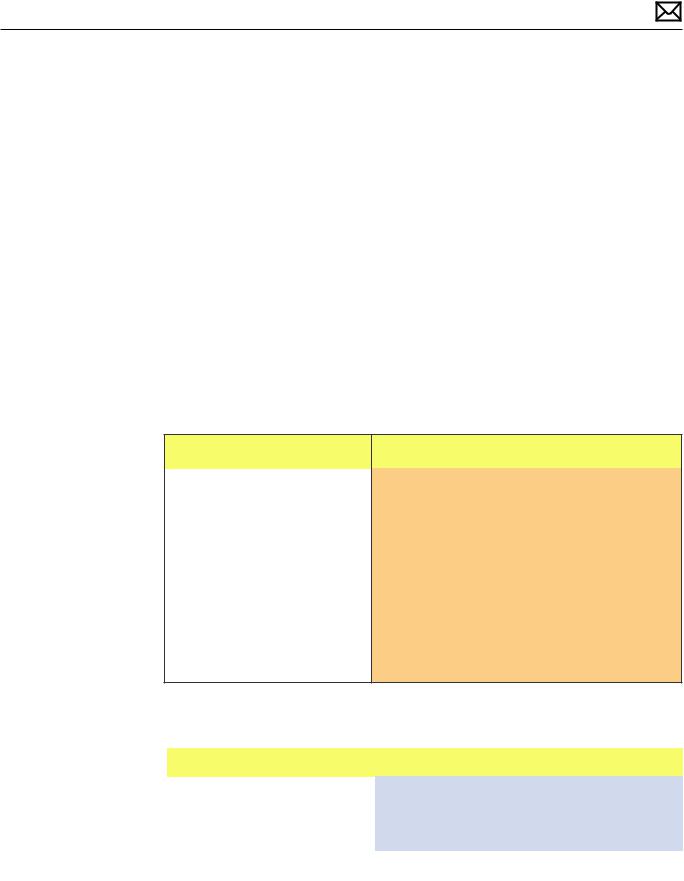
Symptom Charts
Follow the steps in the order indicated below. If an action resolves the issue, retest the system to verify.
Note:A compilation of Quick Check tables is available at http://service.info.apple.com/QRS/ en/quickreference.pdf
Startup and Power Issues
No Power
Unlikely cause:display assembly, speakers, optical drive, hard drive
Quick Check
Symptom |
Quick Check |
|||
|
|
|
||
No Power / Dead Unit |
1. |
Verify AC power presence with MagSafe LED |
||
• |
No power |
|
indicating on or charge state. |
|
• |
No image |
2. |
Verify battery status as being partly charged, |
|
• |
No startup chime |
|
charging with AC power. |
|
• No fan or hard drive spin |
3. |
If battery is not recognized, remove battery and |
||
• No reset sound from optical |
||||
|
try to run from AC only. |
|||
|
drive |
4. |
Reset SMC. |
|
• No sleep LED activity |
||||
5. |
Verify with known-good battery. |
|||
• No light if Caps Lock pressed |
||||
|
|
|||
•Non-operational
Deep Dive
Check |
Result |
Action |
Code |
|
|
|
|
1. Isolate peripherals as cause. |
Yes |
Suspect peripherals as cause. |
|
Disconnect all peripherals and |
|
Reconnect each one at a time, |
|
external devices and verify unit |
|
verifying unit operation as |
|
starts. |
|
external device is reinstalled. |
|
|
|
|
|
|
No |
Go to step 2 |
|
|
|
|
|
2008-10-19 |
MacBook (13-inch, Aluminum, Late 2008) Symptom Charts — Startup and Power Issues 22 |
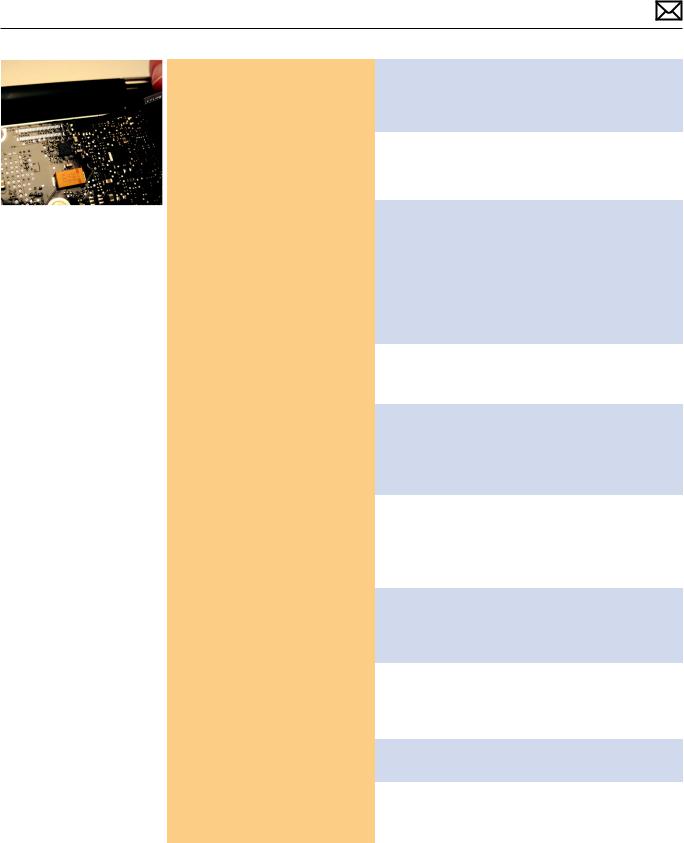
2. Reset SMC., and verify unit |
Yes |
Corrupt SMC state preventing |
|
|
|
starts. (Alternative hardware |
|
power on. Issue resolved with |
|
|
SMC reset can be forced by |
|
SMC reset. |
|
|
shorting R5001 pads on logic |
|
|
|
|
board or removing all system |
|
|
|
|
No |
Go to step 3 |
|
|
|
power for 1 minute.) Can |
|
||
|
|
|
|
|
|
system start up after SMC |
|
|
|
|
reset? |
|
|
|
|
|
|
|
|
3. Will system power up with |
Yes |
System can start up from |
P11 |
|
|
battery only? Check battery |
|
known-good battery -- |
|
|
level LED indicator for status |
|
customer battery possibly at |
|
|
of battery charge or battery |
|
fault or needs to be charged. |
|
|
use error. Inspect battery |
|
Continue to verify customer |
|
|
connector for burn marks or |
|
battery then AC adapter use |
|
|
damaged pins if substituting a |
|
and battery charging. Go to |
|
|
known-good battery to verify |
|
step 4. |
|
|
starting on battery. |
|
|
|
|
No |
System will not power using |
|
|
|
|
|
||
|
|
|
known-good battery only. Go |
|
|
|
|
to step 5 |
|
|
|
|
|
|
4. Customer battery may be run |
Yes |
Battery is recognized, |
|
|
|
down, or not recognized. |
|
charging and health is good. |
|
|
Verify customer battery in |
|
Return to test unit with |
|
|
a known-good system is |
|
customer battery and AC |
|
|
recognized and accepting a |
|
adapter power. Go to step 6. |
|
|
charge. Confirm customer |
|
|
|
|
No |
Replace customer battery |
P10 |
|
|
battery is not consumed nor |
|||
|
defective. |
|
for not charging (P10) or not |
or |
|
|
|
recognized (P11). Customer |
P11 |
|
|
|
to purchase a replacement |
|
|
|
|
|
|
|
|
|
battery if consumed. |
|
|
|
|
|
|
5. |
Inspect battery cable |
Yes |
Battery power restored, return |
|
|
connection at logic board and |
|
to test unit with customer |
|
|
reseat if necessary. Replace |
|
battery and AC adapter |
|
|
cable if found damage or |
|
power. Go to step 6. |
|
|
burned. Can the system power |
|
|
|
|
No |
Logic board is expected to |
|
|
|
on from a charged battery with |
|
||
|
|
power on with battery only. |
|
|
|
battery cable inspections or |
|
|
|
|
|
Inspect and test power on |
|
|
|
replacement? |
|
|
|
|
|
key. Go to step 10. |
|
|
|
|
|
|
|
|
|
|
|
|
6. |
Inspect MagSafe power |
Yes |
Power adapter is good, go to |
|
|
adapter. Verify AC adapter is |
|
step 7 |
|
|
correct wattage, compatible |
|
|
|
|
No |
Release stuck pin or replace |
P14 |
|
|
with product and works on |
|||
|
|
adapter due to wire damage, |
|
|
|
known-good computer. |
|
|
|
|
|
not working or burned pins |
|
|
|
|
|
|
|
|
|
|
|
|
2008-10-19 |
MacBook (13-inch, Aluminum, Late 2008) Symptom Charts — Startup and Power Issues 23 |
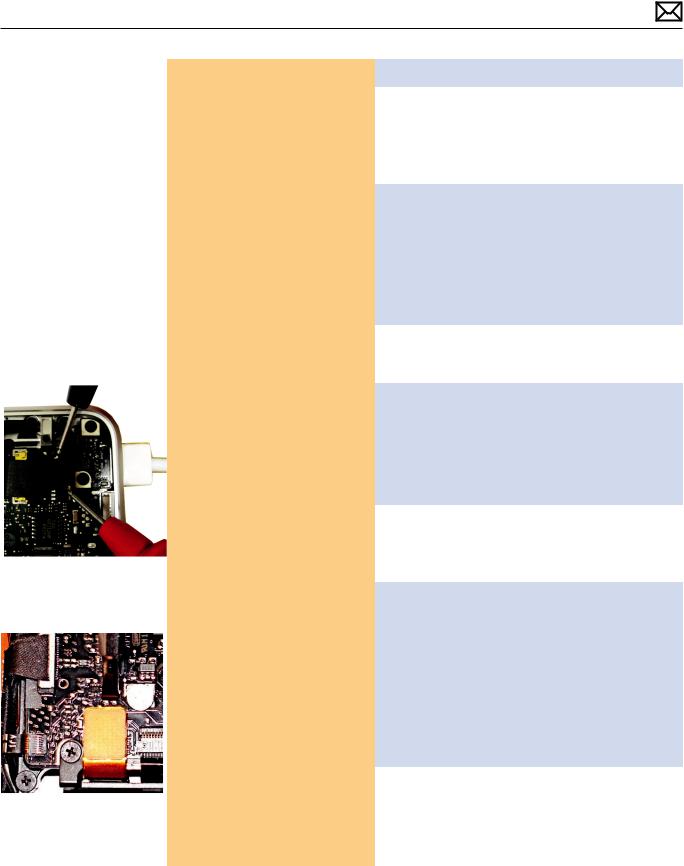
7. |
Inspect MagSafe port on |
Yes |
Go to step 8 |
|
|
computer for physical damage, |
|
|
|
|
No |
Clean port assembly. Replace |
X03 |
|
|
debris or metal fragments |
|||
|
|
MagSafe board if necessary. |
|
|
|
attracted to magnetic |
|
|
|
|
|
|
|
|
|
connector. Is MagSafe |
|
|
|
|
connector clean and free from |
|
|
|
|
defects? |
|
|
|
|
|
|
|
|
8. |
Verify adapter status LED |
Yes |
System starts and has power. |
|
|
turns on green then orange |
|
MagSafe LED indicates power |
|
|
indicating power and battery |
|
is flowing to logic board. |
|
|
charge in progress. |
|
Verify customer battery will |
P11 |
|
A green LED can indicate a full |
|
also charge. Review battery |
|
|
|
|
||
|
battery, removal of battery or |
|
health to ensure customer |
|
|
battery not recognized. |
|
satisfaction. |
|
|
|
|
|
|
|
|
No |
AC power is down or battery |
|
|
|
|
is not charging. Go to step 9 |
|
|
|
|
|
|
9. |
Verify power from adapter is |
Yes |
Logic board has power |
X03 |
|
present on logic board. |
|
adapter energy to start |
|
|
Remove system battery, use AC |
|
system, 16.7V found on Q7001. |
|
|
power only. With DVM, verify |
|
MagSafe cable reseat or |
|
|
voltage presence of Q7001, pin |
|
replacement resolved issue. |
|
|
5 is 16.7Vdc with AC adapter |
|
If still no system power on |
|
|
connected. Reseat or test |
|
indications, go to step 10 |
|
|
known-good MagSafe cable to |
|
|
|
|
No |
No voltage measured on |
|
|
|
achieve power for logic board. |
|
||
|
|
Q7001, AC adapter power not |
M21 |
|
|
|
|
||
|
|
|
going to logic board power |
|
|
|
|
supplies. Replace logic board. |
|
|
|
|
|
|
10. |
Test and inspect Top Case |
Yes |
Power on key works fine, issue |
|
|
Power Button. |
|
resolved. |
|
|
Stuck or open power on |
|
|
|
|
key or keyboard disconnect |
|
Power on key works when |
|
|
can disable the power on |
|
keyboard cable is reseated. |
|
|
of system. If button does |
|
|
|
|
|
Power on key appears to |
K05 |
|
|
not work, locate R5015 pads |
|
||
|
on logic board just above |
|
be stuck, had to remove |
|
|
trackpad connector, and |
|
keyboard cable for R5015 |
|
|
short pads to power up logic |
|
power on. Replace top case |
|
|
board. If power on key is |
|
for stuck power on key |
|
|
stuck, keyboard cable must |
|
|
|
|
No |
No logic board power on |
M01 |
|
|
be disconnected for R5015 to |
|||
|
|
when shorting R5015 pads. |
|
|
|
work. Does system power on? |
|
|
|
|
|
Replace logic board. |
|
|
|
(Reconnect keyboard cable to |
|
|
|
|
|
|
|
|
|
confirm bad or intermittent |
|
|
|
|
connections.) |
|
|
|
|
|
|
|
|
2008-10-19 |
MacBook (13-inch, Aluminum, Late 2008) Symptom Charts — Startup and Power Issues 24 |

Won’t Start Up
Unlikely cause: display assembly, speakers, fan, camera, microphone
Quick Check
Symptom |
Quick Check |
||
|
|
|
|
Power but No start up |
1. |
Reset SMC. |
|
• No startup chime, some video |
2. |
Verify startup process passes initial memory |
|
activity, Apple logo, startup |
|||
|
checks – no beep errors or flashing sleep LED |
||
spin dial |
|
indicators. Display activity is starting up. |
|
• Startup chime with possible |
3. |
Clear PRAM.Verify starts up from user drive. |
|
beep tones. |
|||
4. |
Connect known-good external bootable device |
||
• Fan, hard drive spin or optical |
|||
|
and press Alt key during startup then select |
||
drive reset sound |
|
||
|
external startup device to bring up system for |
||
• Sleep LED is on , blinking or |
|
||
|
diagnostics. |
||
went out |
5. |
Verify presence and status of user hard drive. Use |
|
• Caps Lock LED toggles when |
|||
|
Disk Utility to repair drive and file permissions. |
||
pressed |
|
||
|
|
||
|
|
|
|
Deep Dive
Check |
Result |
Action |
Code |
|
|
|
|
|
|
1. |
Reset SMC and Clear PRAM to |
Yes |
User hard drive bootable, |
|
|
set default startup device to |
|
issue resolved default |
|
|
internal hard disk drive (HDD). |
|
settings. |
|
|
|
|
|
|
|
|
No |
Customer system not starting |
|
|
|
|
up, go to step 2 |
|
|
|
|
|
|
2. |
Is system indicating a memory |
Yes |
Troubleshoot memory issues, |
|
|
error with repeated sleep LED |
|
go to step 3 |
|
|
1 or 3 flash sequence and beep |
|
|
|
|
No |
Continue with startup |
|
|
|
tones if sound is enabled? |
|
||
|
|
sequence verification go to |
|
|
|
|
|
|
|
|
|
|
step 4 |
|
|
|
|
|
|
2008-10-19 |
MacBook (13-inch, Aluminum, Late 2008) Symptom Charts — Startup and Power Issues 25 |

3. |
Reseat customer memory |
Yes |
Customer memory defective |
X02 |
|
and/or swap in known- |
|
and replaced. Continue to |
|
|
good memory to isolate bad |
|
verify startup process. Go to |
|
|
memory and replace defective |
|
step 4 |
|
|
parts. |
|
|
|
|
No |
Should known-good memory |
M07 |
|
|
|
|||
|
|
|
fail in one or more slots, |
|
|
|
|
replace logic board. |
|
|
|
|
|
|
4. |
Hold the Alt (Option) key |
Yes |
System starting up from |
|
|
during startup and verify there |
|
customer hard drive. Startup |
|
|
is a bootable hard drive shown |
|
issue resolved |
|
|
in Startup Manager. Choose |
|
|
|
|
No |
Customer hard drive not |
|
|
|
customer hard drive. Does |
|
||
|
|
present or does not start up |
|
|
|
start up from this drive work? |
|
|
|
|
|
from this drive. Continue to |
|
|
|
|
|
|
|
|
|
|
find bootable device. Go to |
|
|
|
|
step 5 |
|
|
|
|
|
|
5. |
Insert product OS install disc |
Yes |
Starts up from optical drive - |
|
|
in optical drive. Install disc |
|
customer hard drive not yet |
|
|
is bootable and should be |
|
bootable, go to step 8 |
|
|
present in Startup Manager. |
|
|
|
|
No |
Computer has no internal |
|
|
|
Can system start up from OS |
|
||
|
|
bootable devices. Test |
|
|
|
install disc? |
|
|
|
|
|
external startup devices, go |
|
|
|
|
|
|
|
|
|
|
to step 6 |
|
|
|
|
|
|
6. |
Boot from a known-good |
Yes |
System started up from |
|
|
bootable copy of product OS |
|
external device and reports |
|
|
on a USB drive or network |
|
data regarding internal SATA |
|
|
server to start up and verify |
|
devices. Go to step 7 |
|
|
internal mass storage devices |
|
|
|
|
No |
No startup devices available. |
M02 |
|
|
are available using System |
|||
|
|
Replace logic board |
|
|
|
Profiler and Disk Utility. |
|
|
|
|
|
|
|
|
|
|
|
|
|
7. |
Troubleshoot optical drive |
Yes |
Cable reseat solved issue. |
|
|
and optical drive cable with |
|
Continue to verify hard drive |
|
|
cable reseat and known- |
|
issues, go to step 8 |
|
|
good part substitutions. Is |
|
|
|
|
there a defective optical drive |
|
|
|
|
component to replace? |
|
Defective optical drive cable |
X03 |
|
|
|
||
|
|
|
found and replaced. Continue |
|
|
|
|
to verify hard drive issues, go |
|
|
|
|
to step 8 |
|
|
|
|
|
|
|
|
|
Defective optical drive found |
J03 |
|
|
|
and replaced. Continue to |
|
|
|
|
verify hard drive issues, go to |
|
|
|
|
step 8 |
|
|
|
|
|
|
|
|
No |
Replace logic board |
M19 |
|
|
|
|
|
2008-10-19 |
MacBook (13-inch, Aluminum, Late 2008) Symptom Charts — Startup and Power Issues 26 |

8. |
Use Disk Utility loaded from |
Yes |
Customer hard drive available |
|
|
OS install disc to verify if hard |
|
for inspections and repair. Go |
|
|
drive is available on device list. |
|
to step 10. |
|
|
Is customer hard drive listed in |
|
|
|
|
Disk Utility? |
|
|
|
|
No |
Hard drive not present, |
|
|
|
|
|
||
|
|
|
troubleshoot hard drive and |
|
|
|
|
cable. Go to step 9. |
|
|
|
|
|
|
9. |
Troubleshoot hard drive and |
Yes |
Reseat of SATA cable now has |
|
|
hard drive SATA cable with |
|
customer hard drive visible in |
|
|
cable reseat and known-good |
|
Disk Utility, go to step 10 |
|
|
part substitutions. If customer |
|
|
|
|
|
Defective hard drive SATA |
X03 |
|
|
hard drive, is there a defective |
|
||
|
|
cable found and replaced, |
|
|
|
hard drive component to |
|
|
|
|
|
now has customer hard drive |
|
|
|
replace? |
|
|
|
|
|
visible in Disk Utility, go to |
|
|
|
|
|
|
|
|
|
|
step 10 |
|
|
|
|
|
|
|
|
|
Suspect customer hard drive |
|
|
|
|
defective, attempt OS restore, |
|
|
|
|
go to step 10 |
|
|
|
|
|
|
|
|
No |
Known-good hard drive and |
M19 |
|
|
|
known-good hard drive SATA |
|
|
|
|
cable used, still no hard drive |
|
|
|
|
present. Replace logic board |
|
|
|
|
|
|
10. |
Boot system with Shift key |
Yes |
Go to software |
|
|
down. Does it work? |
|
troubleshooting article |
|
|
|
|
|
|
|
|
No |
Go to step 11 |
|
|
|
|
|
|
11. |
Use Disk Utility to repair |
Yes |
OS on customer hard drive |
|
|
customer hard drive and |
|
repaired, issue resolved. |
|
|
repair permissions if system OS |
|
|
|
|
found on hard drive. Is hard |
|
|
|
|
No |
Hard drive not bootable, |
|
|
|
drive bootable after software |
|
||
|
|
perhaps missing OS, go to |
|
|
|
repairs? |
|
|
|
|
|
step 12 |
|
|
|
|
|
|
|
|
|
|
|
|
12. |
Use Disk Utility to partition |
Yes |
Customer hard drive now |
|
|
customer hard drive with one |
|
starts up from new OS image, |
|
|
GUID partition then restore |
|
issue resolved |
|
|
Mac OS from product OS install |
|
|
|
|
disc. Is hard drive bootable |
|
|
|
|
No |
Replace hard drive. |
H02 |
|
|
after OS install? |
|||
|
|
|
|
|
|
|
|
|
|
2008-10-19 |
MacBook (13-inch, Aluminum, Late 2008) Symptom Charts — Startup and Power Issues 27 |

Intermittent Shutdown
Unlikely cause: hard drive, optical drive
Quick Check
Symptom |
Quick Check |
||
|
|
|
|
Intermittent shutdown |
1. |
Verify battery charge status |
|
• Powers off during startup |
2. |
Check AC adapter MagSafe connector and |
|
• Powers off with desktop use |
|||
|
connection with system |
||
|
3. |
Reset SMC and PRAM |
|
|
4. |
Start up with shift key down for safe mode |
|
|
5. |
Start up from known-good bootable device |
|
|
6. |
Check system.log info for shutdown cause |
|
|
7. |
Run AHT /ASD for sensors + thermal test |
|
|
|
|
|
Deep Dive
Check |
Result |
Action |
Code |
|
|
|
|
1. Identify shutdown code |
Yes |
Check for sudden shutdown |
|
recorded in system log file. |
|
error code explanation |
|
Open the system.log file with |
|
in Knowledge Base and |
|
console application. Search |
|
shutdown causes table |
|
for occurrences of“previous |
|
in service manual to find |
|
shutdown cause”return codes. |
|
expected cause of shutdown, |
|
Verify system log looking for |
|
and check item accordingly : |
|
codes that indicate abnormal |
|
|
|
shutdown events. |
|
-Intermittent power means |
|
|
|
checking battery health , AC |
|
|
|
source and MagSafe cable |
|
|
|
seating ; go to step 4 |
|
|
|
-Sleep means running sleep |
|
|
|
sensor test; go to step 7 |
|
|
|
-Overtemp means checking |
|
|
|
for clogged heatsink, shorted |
|
|
|
sensors cables or defective |
|
|
|
fan; go to step 8 |
|
|
|
|
|
|
No |
system.log lists only normal |
|
|
|
shutdown codes, no codes |
|
|
|
related to heat sensors or |
|
|
|
power concerns. Go to step 2 |
|
|
|
|
|
2008-10-19 |
MacBook (13-inch, Aluminum, Late 2008) Symptom Charts — Startup and Power Issues 28 |

2. Reset SMC and clear PRAM; |
Yes |
Shutdown cause related to |
|
then monitor system |
|
SMC or PRAM resolved by |
|
performance to verify if |
|
changing to default settings. |
|
system shutdowns cease. Are |
|
|
|
shutdown symptoms and |
|
|
|
No |
Shutdown event still occurs. |
|
|
events gone? |
|
||
|
Go to step 3. |
|
|
|
|
|
|
|
|
|
|
3. Start up from product OS |
Yes |
Shutdown events cease on |
|
install disc or from an external |
|
known-good OS. Reinstall |
|
hard drive with product Mac |
|
Mac OS on customer hard |
|
OS. |
|
drive and update OS with |
|
Are shutdown symptoms and |
|
latest version and check |
|
events gone while starting up |
|
if bootROM updates are |
|
from this known-good Mac |
|
available. |
|
OS? |
|
|
|
No |
Symptoms unchanged - go to |
|
|
|
|
||
|
|
step 4 |
|
|
|
|
|
4. Check system running on |
Yes |
Recharge customer battery |
P09 |
battery only. Use known-good |
|
and retest. Check for |
|
charged battery. |
|
customer battery health in |
|
Verify that shutdown/reset/ |
|
Apple System Profiler or run |
|
sleep issues disappear when |
|
battery testing utility, and |
|
known-good battery is used |
|
replace if reported battery |
|
without AC adapter. |
|
health is reported bad or |
|
|
|
consumed. |
|
|
|
|
|
|
No |
Symptoms unchanged - Go |
|
|
|
to step 5 |
|
|
|
|
|
5. Check with known-good AC |
Yes |
Faulty adapter. Replace |
P14 |
adapter source only |
|
customer AC adapter if AC |
|
Remove battery and use |
|
cable and duckhead were |
|
known-good AC adapter. |
|
confirmed faulty. |
|
Does the shutdown/reset/ |
|
|
|
No |
Symptoms unchanged - Go |
|
|
sleep issue disappear with |
|
||
|
to step 6 |
|
|
known-good adapter? |
|
|
|
|
|
|
|
|
|
|
|
6. Check if power removed error |
Yes |
If power failure related, check |
|
reported“improper shutdown |
|
adapter-related connections |
X03 |
detected”in system.log |
|
(stuck pins, cable damage, |
|
If shutdown error is related |
|
etc.). If so, replace MagSafe |
|
to power removed shutdown |
|
port connector. |
|
cause, run ASD and check for |
|
|
|
No |
Go to step 9 |
|
|
overvoltage sensor failure |
|
||
|
|
|
|
reported. |
|
|
|
|
|
|
|
2008-10-19 |
MacBook (13-inch, Aluminum, Late 2008) Symptom Charts — Startup and Power Issues 29 |

7. |
Check if sleep event happens |
Yes |
Check for intermittently |
|
|
repeatedly in system.log |
|
shorted sleep sensor in top |
X03 |
|
If sleep/wake events are |
|
case. If damaged, replace |
|
|
repeatedly reported, plug |
|
sensor/cable of top case. |
|
|
external monitor and run ASD |
|
|
|
|
to check for sleep sensor test. |
|
Check IR cable is properly |
X03 |
|
Verify if sleep sensor test is |
|
seated |
|
|
failing. |
|
Reseat and retest sleep sensor |
X03 |
|
|
|
||
|
|
|
with ASD. If failing again, |
|
|
|
|
check for presence of magnet |
|
|
|
|
in display assembly above |
|
|
|
|
sensor. |
|
|
|
|
If magnet present, replace |
M22 |
|
|
|
sensor/cable or top case and |
|
|
|
|
retest. If still sleep sensing |
|
|
|
|
failing, replace logic board |
|
|
|
|
if magnet missing replace |
L15 |
|
|
|
display assembly |
|
|
|
|
|
|
|
|
No |
Go to step 8 |
|
|
|
|
|
|
8. |
Check if over temp cause |
Yes |
-If fan not running failure, |
|
|
reported in system.log |
|
check for fan cable seating |
|
|
If shutdown error is related |
|
and retest. If same failure |
|
|
to over temp shutdown |
|
after retest replace fan with |
M18 |
|
cause, run ASD and verify |
|
known-good fan and retest. |
|
|
that a sensor or fan failure is |
|
If does not happen with |
|
|
reported. |
|
known-good fan, replace fan. |
|
|
|
|
-If over temp failure reported |
|
|
|
|
check for cause of over temp |
|
|
|
|
like obstructed vent, dust |
X03 |
|
|
|
in heatsink fin, or clogged |
|
|
|
|
fan and retest. If still failing |
|
|
|
|
replace part where sensor is |
|
|
|
|
located (logic board, battery, |
|
|
|
|
display assembly or trackpad) |
|
|
|
|
according to the sensor |
|
|
|
|
location table of service |
|
|
|
|
manual. |
|
|
|
|
Go to step 9 |
|
|
|
|
|
|
|
|
No |
Replace Thermal module |
X10 |
|
|
|
Go to step 9 |
|
|
|
|
|
|
2008-10-19 |
MacBook (13-inch, Aluminum, Late 2008) Symptom Charts — Startup and Power Issues 30 |
